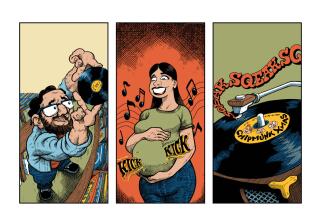Reelin’ in the years: Cassette tapes still have their devotees
WAVERLY, NEB. — The first obituaries for cassette tapes appeared more than 20 years ago, when compact discs hit the market.
Sales of music tapes plummeted from 442 million in 1990 to about 700,000 last year, according to the Recording Industry Assn. of America.
Anyone trying to impress a friend with the perfect combination of songs can probably burn a CD or assemble an MP3 playlist in a matter of minutes. They needn’t spend hours dubbing the perfect tape as the main character did in the novel and movie “High Fidelity.”
But cassette tapes still thrive in specialty markets because of the format’s enduring advantages.
Executives with the last cassette maker in North America, Lenco-PMC Inc., say the plastic cases -- invented in 1964 to hold two miniature reels for magnetic tape -- remain popular for at least three uses: audio books for the blind, court recordings and religious messages.
Lenco General Manager Daryl Chapelle predicts the 200-worker plant just outside Nebraska’s state capital, Lincoln, will make about 22 million cassettes in each of the next several years.
That’s a far cry from the 175 million cassettes Lenco made in 1995 at the height of the business, but Chapelle is confident that demand will remain steady at least through 2009.
“The truth is, new technology does not replace old technology for years,” Chapelle said.
Lenco’s cassettes include everything but the magnetic tape, which is inserted later by another company. That enables audio duplicating companies to record numerous copies at high speed to save time before loading the tape into cassettes.
Lenco thrived in the cassette tape business by making a better cassette than foreign rivals that made a cheaper product.
“We always had trouble competing on price,” Chapelle said. “But typically those cheap imports weren’t consistent. The bigger users had to have consistency to run their machines.”
One of Lenco’s biggest customers today is National Audio Co. in Springfield, Mo., which makes blank and recorded tapes.
National Audio President Steve Stepp said the audiocassette “is still the most versatile, durable, economic recording material ever invented.”
The Library of Congress’ National Library Service for the Blind and Physically Handicapped has relied on cassettes for its audio books since the early 1970s.
“We have found cassettes to be durable,” said Jane Caulton, the program’s spokeswoman. “They have been cost-efficient. And they have been easy for our customers to use.”
Tapes can carry a Braille label to help blind users determine what’s on them, and that wouldn’t work well on CDs because the label would interfere with the operation of slot-loading players.
The library is preparing to switch to a digital medium for its audio books, but that transition depends on getting Congress to approve funding and won’t be done until 2012 at the earliest.
Cassettes are still generally popular for audio books because of a basic advantage they hold over CDs: When someone moves a tape from one player to another, the recording resumes from the place it stopped.
“It is still the 10,000-pound gorilla in the spoken-word world,” Stepp said.
Cassettes are also a popular medium for some religious groups, he said. Tapes are well-suited to recordings of the Bible or small batches of sermons because it’s more cost-effective to record a small number of pieces on tape than on compact disc.
A CD holds about 80 minutes of material, whereas tapes are available in a number of lengths, up to 120 minutes. Stepp said his company charged about 33 cents per CD or 77-minute tape when they’re bought in bulk. But if the recording is shorter or longer than 80 minutes, tapes would be cheaper than CDs.
Also, cassette cases cost less than half what CD cases cost, and tapes can be rerecorded.
Tapes’ durability is a key selling point for groups doing missionary work because they won’t scratch and aren’t as heat sensitive as CDs. “You can take a cassette player out in the middle of a jungle or desert and it will work,” Stepp said.
Even though those groups are likely to continue using cassettes, much of the market has disappeared.
“On the music side, it’s pretty much dead,” Chapelle said.
Tape sales reached new heights in the 1980s -- more than 15 years after its introduction -- thanks to the Sony Walkman and other portable players.
The U.S. market for blank tapes peaked in 1994, when 438.9 million were sold, according to the Content Delivery and Storage Assn., which started in 1970 as the International Tape Assn. to help set standards for tapes.
Today, cassettes account for only about 5% of Lenco’s roughly $34 million in annual revenue. Two production lines in the Waverly plant are dedicated to churning out 42 cassettes a minute, a far cry from the 10 tape production lines once used.
The company has prepared for the cassette’s ultimate end. Nearly a decade ago, Lenco began making an assortment of CD and DVD cases for music and movie distributors.
Cassette tapes’ impressive longevity is unlikely to be matched, said Charles van Horn, president of the content delivery group. “It’s hard to believe we’re going to ever see a product last this long in the industry,” he said.
More to Read
Inside the business of entertainment
The Wide Shot brings you news, analysis and insights on everything from streaming wars to production — and what it all means for the future.
You may occasionally receive promotional content from the Los Angeles Times.










